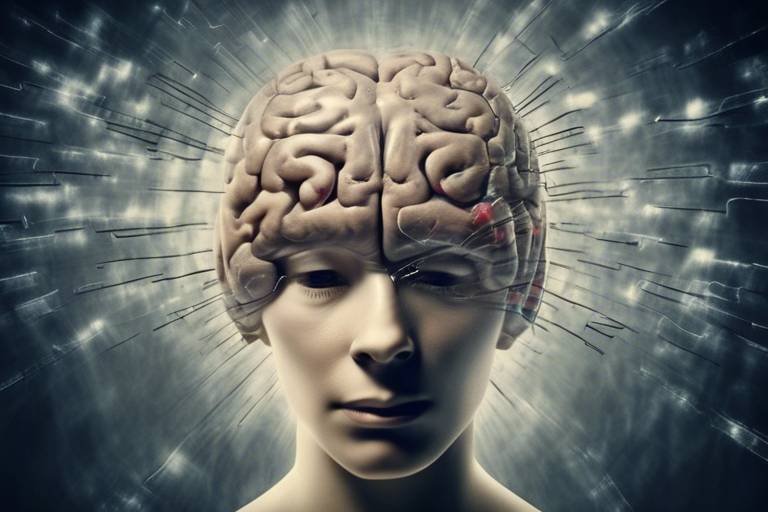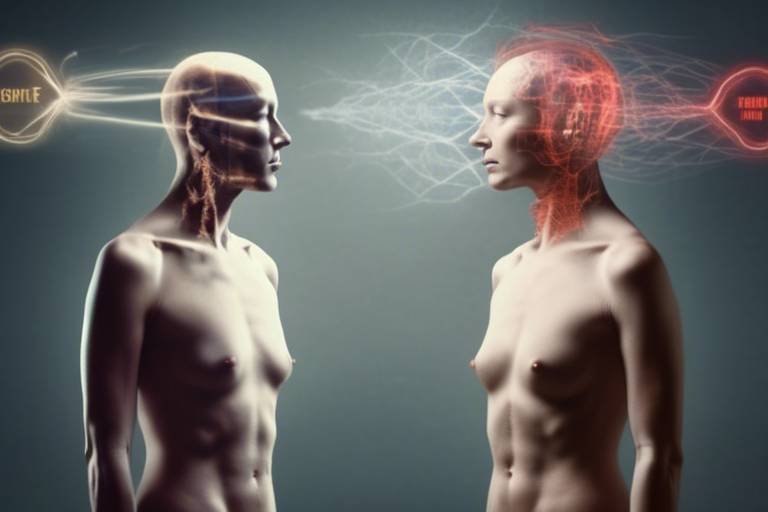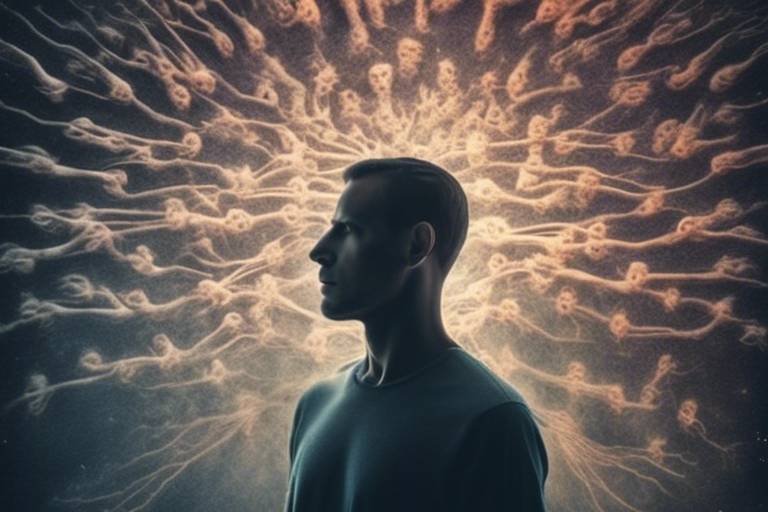Dreams and the Subconscious - A Connection
Have you ever woken up from a dream and thought, "What on earth was that all about?" Dreams are not just random images that flash through our minds while we sleep; they are a complex tapestry woven from the threads of our subconscious. Understanding the connection between dreams and the subconscious can be a fascinating journey into our own minds. It opens a window to our innermost thoughts, feelings, and experiences, allowing us to explore and understand ourselves better.
Think of dreams as a mirror reflecting our hidden desires and fears. They're like a secret language that our mind uses to communicate with us, often in ways that our waking self might find hard to grasp. Have you ever noticed how certain dreams linger in your memory long after you’ve woken up? These dreams often hold significant meaning, acting as clues to what’s happening beneath the surface of our conscious thoughts.
In this article, we will delve into the intricate relationship between dreams and the subconscious mind. We will explore the nature of dreams, the role of the subconscious in shaping them, and how understanding this connection can lead to greater self-awareness. From common dream symbols to the phenomenon of lucid dreaming, we will uncover the layers of meaning behind our nightly adventures.
So, buckle up as we embark on this enlightening journey through the world of dreams and the subconscious. You might just find that your dreams are not as random as they seem, but rather a treasure trove of insights waiting to be discovered.

The Nature of Dreams
Dreams are a captivating aspect of human experience, often leaving us puzzled and intrigued. They are not just random images and sensations that flicker through our minds while we sleep; rather, they are complex phenomena that can reveal much about our innermost thoughts and feelings. During the various stages of sleep, particularly during REM (Rapid Eye Movement) sleep, our brains become incredibly active, creating vivid narratives that can range from the bizarre to the profoundly meaningful.
There are several types of dreams that people commonly experience, each with its own unique characteristics. For instance, some dreams may feel incredibly realistic, almost as if you are living the experience in real-time, while others may seem surreal and nonsensical. Here are a few types of dreams you might encounter:
- Lucid Dreams: In these dreams, you are aware that you are dreaming, which can give you the ability to manipulate the dream's narrative.
- Nightmares: These are distressing dreams that often evoke feelings of fear, anxiety, or terror, usually stemming from unresolved issues or stress.
- Recurring Dreams: Some dreams repeat over time, often indicating that the dreamer is grappling with unresolved emotions or situations.
- Prophetic Dreams: These dreams are believed to predict future events, though the scientific community remains skeptical about their validity.
What’s fascinating is that the content of our dreams can vary significantly from person to person. While one individual might dream of flying freely through the sky, another might find themselves trapped in a never-ending maze. This variability can be attributed to personal experiences, emotions, and even cultural backgrounds. For example, someone who has recently faced a significant life change may have dreams that reflect their feelings of uncertainty and transition.
Moreover, dreams can serve as a mirror to our subconscious, reflecting our hidden desires, fears, and unresolved conflicts. They can act as a sort of emotional processing tool, allowing us to confront issues that we might not be able to address in our waking lives. As such, understanding the nature of dreams can be a powerful pathway to greater self-awareness and emotional healing.
In summary, the nature of dreams is not only a fascinating subject but also a deeply personal experience. They can provide insight into our subconscious mind, revealing layers of our emotions and thoughts that we may not fully comprehend. As we delve deeper into the world of dreams, we begin to unlock the mysteries of our psyche, paving the way for personal growth and understanding.

The Role of the Subconscious
The subconscious mind is like the vast ocean beneath the surface of our daily lives, holding a treasure trove of memories, emotions, and experiences that shape who we are. While we may consciously focus on our immediate surroundings and tasks, our subconscious is constantly at work, influencing our thoughts, feelings, and even our actions in ways we often don't realize. But what exactly does the subconscious do, and how does it play a role in our dreams?
First off, the subconscious acts as a storage unit for all the information we encounter throughout our lives. This includes everything from significant events to everyday experiences, and even the smallest details that we might overlook. It's fascinating to think that every interaction, every emotion, and every thought we have is tucked away in this mental archive, ready to resurface when triggered by a dream or a waking moment. For instance, you might dream about a long-forgotten childhood event, and that memory could be linked to a current feeling or situation in your life.
Moreover, the subconscious mind is a powerful influencer of our behaviors and decisions. It often operates behind the scenes, guiding us based on ingrained beliefs and past experiences. This can be particularly evident in our dreams, where unresolved issues or suppressed emotions bubble to the surface. For example, if you're anxious about an upcoming presentation, your subconscious might manifest that anxiety in a dream where you're unprepared or lost. The dream serves as a reflection of your inner turmoil, allowing you to confront those feelings in a safe space.
Another intriguing aspect of the subconscious is its role in creativity and problem-solving. Have you ever had a brilliant idea pop into your head right after waking up? That’s your subconscious at work! It often continues processing information while we sleep, allowing us to connect the dots in ways our conscious mind might miss. Many artists, writers, and inventors have credited their dreams with providing inspiration or solutions to complex problems. It's as if the subconscious is a wise guide, helping us navigate through challenges by presenting ideas in dream form.
Understanding the role of the subconscious also involves recognizing its influence on our emotional responses. Our dreams can act as a mirror, reflecting our deepest fears, desires, and unresolved conflicts. For instance, if you're experiencing stress in your waking life, you might find yourself dreaming about being chased or falling. These dreams can be indicative of your subconscious trying to process feelings of insecurity or fear. By paying attention to these dream narratives, we can gain valuable insights into our emotional state and work towards healing.
To sum it up, the subconscious mind is an essential player in the theater of our dreams. It holds the key to understanding ourselves better, revealing the intricate connections between our past experiences, present emotions, and future aspirations. By exploring our dreams and the messages they convey, we can unlock a deeper awareness of our inner selves and navigate the complexities of life with greater clarity.
- What is the subconscious mind?
The subconscious mind is the part of our mind that stores all our memories, beliefs, and experiences, influencing our thoughts and behaviors without our conscious awareness.
- How do dreams relate to the subconscious?
Dreams often reflect the thoughts, feelings, and unresolved issues held in our subconscious, providing insights into our emotional state.
- Can I control my dreams?
Yes, through techniques like lucid dreaming, you can become aware that you are dreaming and even control the direction of your dreams.
- Why do I have recurring dreams?
Recurring dreams often indicate unresolved issues or persistent thoughts that your subconscious is trying to bring to your attention.

Understanding Dream Symbols
Have you ever woken up from a dream and thought, "What on earth was that all about?" You're not alone! Dreams are like a mysterious code that our subconscious mind uses to communicate with us. They often come wrapped in symbols that can hold significant meaning, revealing our deepest thoughts and feelings. Understanding these symbols can be a powerful tool for self-discovery and personal growth.
Dream symbols can be incredibly varied, often reflecting our individual experiences and emotions. For instance, dreaming about water might symbolize your emotional state. Calm water could suggest peace, whereas turbulent waves might indicate stress or anxiety. Similarly, dreaming of flying often represents a desire for freedom or escape from life's pressures. These symbols can serve as mirrors, reflecting our internal struggles, desires, and fears.
To help you decode your dreams, here are some common dream symbols and their potential meanings:
- Falling: This can signify a loss of control or feelings of insecurity in your waking life.
- Chasing: Being chased in a dream may point to avoidance of a situation or emotion that needs addressing.
- Teeth falling out: This often relates to concerns about appearance or self-image.
However, dream symbols can also be deeply personal. For example, if you had a beloved pet who passed away, dreaming of that pet might evoke feelings of nostalgia or grief. These personal symbols can provide insights into your subconscious, revealing unresolved emotions or memories that need attention.
It's essential to note that while some symbols have universal meanings, the context of your dream and your personal associations will ultimately shape their significance. Keeping a dream journal can be an effective way to track your dreams and identify recurring symbols. By writing down your dreams as soon as you wake up, you can capture the details that might fade away as the day progresses. Over time, you may start to see patterns and gain a clearer understanding of what your subconscious is trying to communicate.
In conclusion, understanding dream symbols is like learning a new language—the language of your subconscious. By paying attention to the messages your dreams convey, you can unlock a treasure trove of insights about yourself. So the next time you wake up from a vivid dream, take a moment to reflect on the symbols and what they might mean for your waking life.
Q: How can I remember my dreams better?
A: Keeping a dream journal next to your bed can help. Write down your dreams as soon as you wake up to capture the details before they fade.
Q: Are all dream symbols universal?
A: Not all symbols are universal. While some symbols have common meanings, personal experiences and emotions greatly influence their significance.
Q: Can I control my dreams?
A: Yes! Techniques like lucid dreaming can help you become aware that you're dreaming, allowing you to take control of the dream narrative.

Universal vs. Personal Symbols
When diving into the world of dreams, one of the most intriguing aspects is the symbolism that we encounter. Dreams often speak a language of their own, using symbols to convey messages from our subconscious. These symbols can be broadly categorized into two types: universal symbols and personal symbols.
Universal symbols are those that appear across cultures and societies, resonating with a collective human experience. For instance, dreaming of water often signifies emotions or the unconscious mind, while flying can represent freedom or escape. These symbols tend to have consistent meanings, regardless of who dreams them. They tap into shared human experiences and emotions, making them a fascinating subject of study. Here’s a quick look at some common universal symbols:
| Symbol | Common Interpretation |
|---|---|
| Water | Emotions, the unconscious |
| Flying | Freedom, escape |
| Falling | Loss of control, fear of failure |
| Teeth Falling Out | Insecurity, fear of aging |
On the other hand, personal symbols are unique to the individual dreaming them. They often stem from personal experiences, memories, and emotions that shape a person’s life. For example, if someone has a cherished childhood memory associated with a particular animal, dreaming of that animal might evoke feelings of comfort or nostalgia. Personal symbols can also be influenced by significant life events, relationships, or even hobbies. Because of their unique nature, the interpretation of personal symbols tends to be more subjective and can vary widely from one person to another.
Understanding the difference between these two types of symbols is crucial for effective dream interpretation. While universal symbols can provide a general framework for understanding dreams, personal symbols offer deeper insights into the dreamer’s psyche. It’s like having a map that shows you the main highways (universal symbols) while also guiding you through the hidden paths of your own experiences (personal symbols).
To effectively interpret your dreams, consider the following:
- Identify any universal symbols that appear in your dreams and research their meanings.
- Reflect on your personal experiences and feelings associated with the symbols that are unique to you.
- Keep a dream journal to track recurring symbols and themes over time, allowing for deeper insights.
By recognizing and analyzing both universal and personal symbols, you can unlock the secrets of your dreams and gain a better understanding of your subconscious mind. This exploration can lead to profound self-discovery and personal growth, revealing the hidden layers of your thoughts and emotions.

Interpreting Your Dreams
Interpreting your dreams can be a fascinating journey into your subconscious, offering a unique lens through which to understand your innermost thoughts and feelings. Have you ever woken up from a dream that felt so real, yet left you puzzled about its meaning? You're not alone! Many people find themselves intrigued by the messages that their dreams may convey. It’s like diving into a treasure chest filled with hidden gems of insight, waiting to be uncovered.
To start interpreting your dreams, it’s essential to maintain a dream journal. This simple practice can be incredibly insightful. As soon as you wake up, jot down everything you remember about your dream. The details can fade quickly, so capturing them right away is crucial. Over time, you’ll begin to notice patterns or recurring themes that may reveal something significant about your waking life.
When analyzing your dreams, consider the following key elements:
- Emotions: Pay attention to how you felt during the dream. Emotions can be powerful indicators of what your subconscious is trying to express.
- Symbols: Dreams often contain symbols that may not be immediately clear. For instance, dreaming of flying might symbolize a desire for freedom or escape.
- People: The individuals in your dreams can represent aspects of yourself or your relationships with others. Think about what these people mean to you.
- Settings: The environment of your dream can provide context. A familiar place might evoke comfort, while an unfamiliar one could suggest anxiety or uncertainty.
Once you’ve gathered your dream details, try to connect them to your current life situations. Ask yourself questions like: What challenges am I facing right now? Are there unresolved issues in my life that this dream might be addressing? By reflecting on these connections, you can unlock deeper meanings behind your dreams.
Moreover, don’t shy away from exploring different dream interpretation theories. For instance, Sigmund Freud believed that dreams are a window into our repressed desires, while Carl Jung viewed them as a means of communicating with our unconscious. Each perspective can offer valuable insights, so feel free to mix and match ideas to find what resonates with you.
Ultimately, interpreting your dreams isn’t a one-size-fits-all process. It’s more of a personal exploration, akin to piecing together a puzzle. As you become more attuned to your dreams, you’ll find that they can serve as a guide, helping you navigate your thoughts, emotions, and experiences. So, the next time you drift off to sleep, remember that your dreams are not just random images; they are a powerful tapestry woven from the threads of your subconscious mind.
Q: How can I improve my dream recall?
A: Keeping a dream journal by your bedside and writing down your dreams immediately upon waking can significantly improve your recall.
Q: Are all dreams meaningful?
A: While some dreams may carry significant meanings, others might simply be the brain's way of processing information. It varies from person to person.
Q: Can I learn to control my dreams?
A: Yes! Techniques such as reality checks and keeping a dream journal can help you achieve lucidity and control over your dreams.
Q: What should I do if I have a recurring nightmare?
A: Consider exploring the underlying issues that may be causing the nightmare. Speaking with a therapist can also help you address these fears.

Lucid Dreaming
Imagine being in a dream where you suddenly realize that you are dreaming. This is the essence of —a fascinating state of consciousness that allows you to take control of your dreams and explore your subconscious in ways that feel incredibly real. It's like being the director of your own movie, where you can change the plot, fly through the skies, or even meet your favorite fictional characters. Sounds exciting, right? But how do you get there?
First, it's essential to understand that lucid dreaming isn't just a whimsical fantasy; it’s a skill that can be cultivated. Many people experience lucid dreams spontaneously, but for those who want to increase the frequency of these dreams, several techniques can help. Here are some popular methods:
- Reality Checks: Throughout your day, regularly ask yourself, "Am I dreaming?" This habit can carry over into your dreams, triggering lucidity.
- Keep a Dream Journal: Write down your dreams as soon as you wake up. This practice enhances your dream recall and helps you recognize patterns in your dreams.
- Mnemonic Induction of Lucid Dreams (MILD): Before sleeping, tell yourself that you will realize you are dreaming. This intention can help you become aware during your dreams.
- Wake Back to Bed (WBTB): Wake up after 5-6 hours of sleep, stay awake for a short period, and then go back to sleep. This technique increases the likelihood of entering REM sleep, where most vivid dreams occur.
Once you achieve lucidity, the possibilities are endless. You can confront fears, practice skills, or simply enjoy the surreal landscapes of your imagination. Many lucid dreamers report profound experiences that lead to increased creativity, enhanced problem-solving skills, and even emotional healing. It’s as if the subconscious mind opens a treasure chest of insights and revelations when you step into the realm of lucid dreams.
However, it’s important to approach lucid dreaming with a sense of responsibility. Just like any powerful tool, it can be misused. Some people may find themselves in overwhelming or frightening scenarios, especially if they haven’t learned how to navigate their dreams effectively. Therefore, it’s crucial to practice grounding techniques and maintain a positive mindset when exploring this fascinating state.
In conclusion, lucid dreaming offers an incredible opportunity to connect with your subconscious, explore your inner world, and even influence your waking life. By mastering the techniques to induce lucidity, you can unlock a new dimension of self-discovery and creativity. So, the next time you drift off to sleep, remember: the dream world is your playground, and you hold the keys to the adventure!
1. Is lucid dreaming safe?
Yes, for most people, lucid dreaming is considered safe. However, it’s essential to approach it with mindfulness and self-awareness to avoid overwhelming experiences.
2. Can everyone learn to lucid dream?
While not everyone may achieve lucidity easily, many can learn techniques to increase their chances of experiencing lucid dreams.
3. Will lucid dreaming affect my sleep quality?
Lucid dreaming does not inherently affect sleep quality, but if you wake up frequently to induce lucidity, it may impact your overall rest.
4. How can I remember my dreams better?
Keeping a dream journal and practicing reality checks during the day can significantly improve your dream recall.
5. Can lucid dreaming help with nightmares?
Yes, many people use lucid dreaming as a technique to confront and overcome their nightmares, allowing them to regain control in frightening situations.

Common Dream Themes
Have you ever woken up from a dream and thought, "What on earth was that all about?" You're not alone! Many people experience recurring themes in their dreams, and these themes often hold significant meaning. Dreams can be like a mirror reflecting our innermost thoughts, feelings, and experiences. They can be puzzling, enlightening, or even downright bizarre. Some common dream themes include being chased, falling, flying, or losing something valuable. Each of these themes can reveal a lot about our emotional state and subconscious mind.
For instance, dreaming of being chased might indicate that you're avoiding a situation in your waking life. It’s like your subconscious is giving you a gentle nudge, saying, "Hey, you need to deal with this!" Similarly, falling can symbolize feelings of insecurity or loss of control. It's as if your mind is telling you that you’re on shaky ground in some area of your life. Flying dreams, on the other hand, can evoke feelings of freedom and empowerment, suggesting that you are overcoming obstacles or seeking liberation from something that has been holding you back.
Let’s dive deeper into some of the most common dream themes:
- Being Chased: This theme often reflects anxiety or stress in your life. It might be related to a specific situation or a more general sense of unease.
- Falling: Falling dreams can indicate feelings of inadequacy or a fear of losing control. They may also point to a fear of failure.
- Flying: These dreams can symbolize freedom and the desire to escape from the pressures of life. They often leave you feeling exhilarated.
- Teeth Falling Out: This is a common theme that can represent anxiety about appearance or fear of aging.
- Being Naked in Public: This theme might reflect feelings of vulnerability or exposure. It’s as if your subconscious is revealing your insecurities.
Understanding these themes can help you unravel the messages your subconscious is trying to communicate. Think of your dreams as a storybook of your emotions and experiences. Each theme is a chapter that reveals more about who you are and what you might be going through. By paying attention to these recurring themes, you can gain valuable insights into your mental and emotional state.
Moreover, it's essential to recognize that while some themes may be universal, others can be deeply personal. For example, if you frequently dream about a specific location, person, or event, it might hold unique significance for you. This is where the beauty of dream interpretation comes into play. It’s not just about identifying the theme; it’s about understanding what it means for you personally.
In conclusion, dreams are a fascinating window into our subconscious mind. By exploring common dream themes, we can better understand ourselves and our emotional landscape. So, the next time you wake up from a dream that leaves you puzzled, take a moment to reflect on the themes present. What might your subconscious be trying to tell you?
Q: Why do I keep having the same dream?
A: Recurring dreams often indicate unresolved issues or emotions that your subconscious is trying to process. They can serve as a reminder to address these concerns in your waking life.
Q: Are dreams a reflection of reality?
A: While dreams can be influenced by real-life experiences, they often incorporate elements of our fears, desires, and emotions, making them a unique blend of reality and imagination.
Q: Can I control my dreams?
A: Yes! Through techniques like lucid dreaming, you can learn to become aware that you are dreaming and even influence the direction of your dreams.
Q: Do dreams have universal meanings?
A: Some dream symbols have universal meanings, but personal experiences and feelings significantly shape the interpretation of dreams.

Nightmares and Their Causes
Nightmares can be some of the most unsettling experiences we face during sleep, often leaving us waking in a cold sweat, heart racing, and struggling to shake off the lingering feelings of fear. But what exactly causes these vivid and distressing dreams? The truth is, nightmares can stem from a variety of sources, and understanding them can be the first step in alleviating their grip on our subconscious.
One of the primary causes of nightmares is stress and anxiety. Just like a pressure cooker, when our minds are filled with unresolved tensions—whether from work, relationships, or personal issues—these feelings can boil over into our dreams. Imagine trying to carry a heavy backpack up a steep hill; eventually, that weight becomes too much, and it spills out. Similarly, our subconscious may express these burdens through nightmarish scenarios.
Moreover, trauma plays a significant role in triggering nightmares. Individuals who have experienced traumatic events, such as accidents, natural disasters, or personal losses, may find their dreams revisiting those dark moments. It’s as if the subconscious is trying to process the trauma, but instead, it manifests as frightening dreams that replay the horror. This phenomenon is often observed in those with Post-Traumatic Stress Disorder (PTSD), where nightmares serve as a haunting reminder of their past.
Additionally, substance use can contribute to the frequency and intensity of nightmares. Alcohol, drugs, and even certain medications can disrupt sleep patterns and affect the brain's ability to process emotions. For instance, while alcohol may initially help you fall asleep, it often leads to fragmented sleep and increased chances of nightmares during the REM (Rapid Eye Movement) phase, when most vivid dreaming occurs. It's like trying to paint a masterpiece with a brush that keeps breaking; the results are often chaotic and unsettling.
Another factor to consider is sleep disorders. Conditions such as insomnia, sleep apnea, and narcolepsy can lead to disturbances in the sleep cycle, which may increase the likelihood of nightmares. When our sleep is fragmented, it can create an environment ripe for distressing dreams. Think of it as trying to build a house on a shaky foundation; the instability can lead to all sorts of issues, including nightmares.
To better understand the relationship between nightmares and their causes, let’s take a look at a table summarizing some common triggers:
| Trigger | Description |
|---|---|
| Stress and Anxiety | Unresolved tensions from daily life manifesting in dreams. |
| Trauma | Revisiting past traumatic events through nightmarish scenarios. |
| Substance Use | Disruptions in sleep patterns due to drugs or alcohol. |
| Sleep Disorders | Conditions that fragment sleep and increase nightmare frequency. |
Recognizing these triggers is essential for anyone looking to reduce the occurrence of nightmares. It’s also important to note that some individuals may experience nightmares without a clear cause, which can be frustrating. In such cases, keeping a dream journal can be beneficial. By recording your dreams, you may begin to identify patterns or recurring themes that can shed light on your subconscious fears and anxieties.
In conclusion, nightmares can be a complex interplay of various factors, including stress, trauma, substance use, and sleep disorders. By understanding these causes, we can take proactive steps to address them, ultimately leading to a more peaceful night’s sleep. So, the next time you wake up from a nightmare, remember that you’re not alone, and there are ways to confront and manage the fears that haunt you in the dark.
- What are nightmares? Nightmares are distressing dreams that cause feelings of fear, anxiety, or sadness, often waking the dreamer.
- How can I reduce nightmares? Reducing stress, maintaining a healthy sleep routine, and avoiding certain substances can help.
- Are nightmares a sign of mental health issues? While not always, frequent nightmares can be indicative of underlying mental health concerns, such as anxiety or PTSD.
- Can children have nightmares? Yes, nightmares are common in children due to their developing minds and experiences.
- Is it possible to control nightmares? Techniques like lucid dreaming may help individuals gain control over their dreams.

Using Dreams for Problem Solving
Have you ever woken up from a dream and thought, "Wow, that was exactly what I needed!"? Dreams can be a treasure trove of insights and solutions, often presenting us with answers to problems we've been grappling with in our waking lives. The connection between our subconscious and our dreams can facilitate a unique form of problem-solving that is both creative and profound. When we sleep, our minds are free from the constraints of logic and reason, allowing us to explore ideas and scenarios that we might not consider when we're awake.
One of the most fascinating aspects of using dreams for problem-solving is the way they can present challenges in a new light. For example, if you're stuck on a work project, your subconscious might create a dream where you're navigating through a maze, representing the twists and turns of your current situation. In this dream, you might find a hidden door that leads you to a solution you hadn’t considered before. This metaphorical representation can help you see your problem from a different angle and inspire creative solutions.
To tap into this powerful resource, consider keeping a dream journal. Writing down your dreams immediately after waking can help capture those fleeting thoughts and images before they fade away. By reviewing your dreams over time, you may start to notice patterns or recurring themes that can provide valuable insights into your life and challenges. For instance, if you frequently dream about being chased, it might indicate that you're avoiding a particular issue or fear in your waking life. Recognizing these patterns can be the first step toward addressing the underlying problems.
Moreover, there are specific techniques you can employ to enhance your problem-solving abilities through dreams:
- Set an Intention: Before going to bed, clearly define the problem you want to solve. This could be as simple as saying, "Tonight, I want to dream about how to handle my workload." By setting a clear intention, you signal your subconscious to focus on that issue while you sleep.
- Visualize the Solution: As you drift off, visualize the problem and imagine potential solutions. This practice can help your mind work through the problem while you dream.
- Practice Lucid Dreaming: Becoming aware that you are dreaming can allow you to manipulate the dream environment. This way, you can actively seek out solutions or confront challenges directly in your dream state.
Dreams can also serve as a source of inspiration for creative projects. Many artists, writers, and inventors have credited their dreams with sparking innovative ideas. For instance, the famous chemist August Kekulé claimed that he discovered the structure of benzene after dreaming of a snake eating its own tail. Such stories illustrate the incredible potential of our dreams to unlock new ways of thinking and problem-solving.
In conclusion, the next time you find yourself facing a dilemma, consider turning to your dreams for guidance. By engaging with your subconscious through dream journaling, setting intentions, and exploring lucid dreaming, you can harness the creative power of your dreams to find solutions to your waking life challenges. Remember, your dreams are not just random images; they are a reflection of your mind's deepest workings, ready to help you tackle the problems you face.
- Can everyone use dreams for problem-solving? Yes! Anyone can learn to harness their dreams for insights and solutions, but it may take practice to become attuned to your subconscious.
- What if I don't remember my dreams? Keeping a dream journal and practicing relaxation techniques before bed may help improve dream recall.
- How can I encourage lucid dreaming? Techniques such as reality checks during the day and setting intentions before sleep can help increase your chances of having lucid dreams.
- Are there specific types of problems that dreams are better at solving? Dreams can be particularly effective for creative problems, emotional challenges, and situations where conventional thinking has failed.
Frequently Asked Questions
- What are dreams, and why do we have them?
Dreams are fascinating experiences that occur during sleep, often reflecting our thoughts, emotions, and experiences. They serve various purposes, including processing memories, solving problems, and even expressing our subconscious desires. It's like your mind's way of organizing the chaos of your day!
- How does the subconscious mind influence our dreams?
The subconscious mind plays a pivotal role in shaping our dreams. It stores our memories, emotions, and experiences, which can surface in our dreams as symbols and themes. Think of it as a vast library where every book represents a piece of your life, and your dreams are the stories that unfold from those books.
- What do dream symbols mean?
Dream symbols are representations of our feelings and experiences, often holding personal significance. For example, dreaming of water might symbolize emotions, while flying could represent freedom. Understanding these symbols can provide valuable insights into our subconscious and help us connect with our inner selves.
- Are there universal symbols in dreams?
Yes, some symbols appear universally in dreams, such as falling or being chased. These symbols often reflect common human experiences and emotions. However, personal symbols also play a crucial role, as they can vary significantly from person to person based on individual life experiences.
- How can I interpret my dreams?
Interpreting dreams involves reflecting on the emotions and symbols present in them. Keeping a dream journal can help track recurring themes and symbols. Ask yourself questions like, "What was I feeling during the dream?" or "What events in my life might relate to this dream?" This can enhance your self-awareness and understanding.
- What is lucid dreaming, and how can I achieve it?
Lucid dreaming is the state of being aware that you are dreaming while still in the dream. Techniques to achieve lucidity include reality checks throughout the day and keeping a dream journal. Once you become aware in a dream, you can often control the dream's direction, making it a powerful tool for personal growth.
- What are some common themes in dreams?
Common dream themes include falling, being chased, or losing teeth. These themes often reflect our anxieties, fears, or life transitions. By exploring these themes, we can gain insights into our emotional state and what our subconscious might be trying to communicate.
- What causes nightmares?
Nightmares can be distressing and often stem from stress, anxiety, or unresolved issues. They can also be linked to traumatic experiences. Understanding the underlying causes can help address the fears that manifest in these intense dreams, allowing for better emotional processing.
- Can dreams help with problem-solving?
Absolutely! Dreams can serve as a creative outlet for problem-solving. Many people have reported gaining insights or solutions to challenges they face in waking life through their dreams. It's like your subconscious works on the problem while you sleep, often leading to those "aha!" moments when you wake up.



















